Design for Manufacturing and Assembly (DfMA) and Design for Deconstruction (DfD) in the Construction Industry: Challenges, Trends and Developments
Abstract
1. Introduction
2. Methodology
3. Discussion
3.1. An Overview of DfMA and DfD
3.2. DfMA in the Construction Industry
3.3. DfD in the Construction Industry
- Design of reversible connections;
- Utilization of demountable fasteners and elimination of adhesives;
- Ease of access to connections using tools at the disassembly stage;
- Simplification and standardization of shapes and connection details;
- Reduction in the number of connection elements;
- Reduction in the variety of member sizes.
3.4. Integration of DfMA and DfD in the Construction Industry
4. Research Gaps and Challenges
4.1. Standard Construction-Oriented DfMA Guidelines
4.2. DfMA Tools in Previous Studies
4.3. Integration with Emerging Technologies
4.4. Comparison of DfMA and DfD with Conventional Methods
4.5. Application of DfD for Structures
4.6. Integration of DfMA and DfD
4.7. Sustainability Assessment of DfMA and DfD Structures
4.8. Barriers to Adoption of DfMA and DfD
5. Conclusions
Author Contributions
Funding
Institutional Review Board Statement
Informed Consent Statement
Data Availability Statement
Acknowledgments
Conflicts of Interest
References
- Ebikake, O.E.; Sassanelli, C.; Terzi, S. PSS design through Design for Supply Chain: State of the art review. Procedia CIRP 2018, 70, 198–203. [Google Scholar] [CrossRef]
- Sassanelli, C.; Urbinati, A.; Rosa, P.; Chiaroni, D.; Terzi, S. Addressing circular economy through design for X approaches: A systematic literature review. Comput. Ind. 2020, 120, 103245. [Google Scholar] [CrossRef]
- Charef, R.; Lu, W.; Hall, D. The transition to the circular economy of the construction industry: Insights into sustainable approaches to improve the understanding. J. Clean. Prod. 2022, 364. [Google Scholar] [CrossRef]
- Kasarda, M.E.; Terpenny, J.P.; Inman, D.; Precoda, K.R.; Jelesko, J.; Sahin, A.; Park, J. Design for adaptability (DFAD)—A new concept for achieving sustainable design. Robot. Comput. Manuf. 2007, 23, 727–734. [Google Scholar] [CrossRef]
- Sassanelli, C.; Pezzotta, G.; Pirola, F.; Terzi, S.; Rossi, M. Design for Product Service Supportability (DfPSS) Approach: A State of the Art to Foster Product Service System (PSS) Design. Procedia CIRP 2016, 47, 192–197. [Google Scholar] [CrossRef]
- Dombrowski, U.; Schmidt, S.; Schmidtchen, K. Analysis and Integration of Design for X Approaches in Lean Design as basis for a Lifecycle Optimized Product Design. Procedia CIRP 2014, 15, 385–390. [Google Scholar] [CrossRef]
- Wasim, M.; Han, T.M.; Huang, H.; Madiyev, M.; Ngo, T.D. An approach for sustainable, cost-effective and optimised material design for the prefabricated non-structural components of residential buildings. J. Build. Eng. 2020, 32, 101474. [Google Scholar] [CrossRef]
- Vaz-Serra, P.; Wasim, M.; Egglestone, S. Design for manufacture and assembly: A case study for a prefabricated bathroom wet wall panel. J. Build. Eng. 2021, 44. [Google Scholar] [CrossRef]
- Volotinen, J.; Lohtander, M. The re-design of the ventilation unit with DFMA aspects: Case study in Finnish industry. Procedia Manuf. 2018, 25, 557–564. [Google Scholar] [CrossRef]
- Bhandari, S.; Jahedi, S.; Riggio, M.; Muszynski, L.; Luo, Z.; Polastri, A. CLT modular low-rise buildings: A DfMA approach for deployable structures using low-grade timber. In Proceedings of the World Conference on Timber Engineering 2021, WCTE 2021, Santiago, Chile, 9–12 August 2021. [Google Scholar]
- Zamani, E.; Dounas, T. A generative design case study for UAV-based assembly and fabrication: Parametric analysis and synthesis of Iranian-Islamic Muqarnas. Open House Int. 2021, 46, 476–493. [Google Scholar] [CrossRef]
- Tasalloti, H.; Eskelinen, H.; Kah, P.; Martikainen, J. An integrated DFMA–PDM model for the design and analysis of challenging similar and dissimilar welds. Mater. Des. 2016, 89, 421–431. [Google Scholar] [CrossRef]
- Tan, T.; Lu, W.; Li, C.; Chen, K.; Tan, G. Implementation of Design for Manufacture and Assembly (DfMA) Principles in Construction: A Case Study. In Proceedings of the Construction Research Congress 2020: Project Management and Controls, Materials, and Contracts—Selected Papers from the Construction Research Congress 2020, Tempe, Arizona, 8–10 March 2020; pp. 907–915. [Google Scholar]
- Bogue, R. Design for manufacture and assembly: Background, capabilities and applications. Assem. Autom. 2012, 32, 112–118. [Google Scholar] [CrossRef]
- Boothroyd, G. Product design for manufacture and assembly. Comput. Des. 1994, 26, 505–520. [Google Scholar] [CrossRef]
- Song, X.T.; Kuo, J.Y.; Chen, C.H. Design methodologies for conventional and additive manufacturing. In Digital Manufacturing; Elsevier: Amsterdam, The Netherlands, 2022; pp. 97–143. [Google Scholar] [CrossRef]
- Rios, F.C.; Chong, W.K.; Grau, D. Design for Disassembly and Deconstruction—Challenges and Opportunities. Procedia Eng. 2015, 118, 1296–1304. [Google Scholar] [CrossRef]
- Bertino, G.; Kisser, J.; Zeilinger, J.; Langergraber, G.; Fischer, T.; Österreicher, D. Fundamentals of Building Deconstruction as a Circular Economy Strategy for the Reuse of Construction Materials. Appl. Sci. 2021, 11, 939. [Google Scholar] [CrossRef]
- Tan, T.; Lu, W.; Tan, G.; Xue, F.; Chen, K.; Xu, J.; Wang, J.; Gao, S. Construction-Oriented Design for Manufacture and Assembly Guidelines. J. Constr. Eng. Manag. 2020, 146, 04020085. [Google Scholar] [CrossRef]
- Xu, J.; Lu, W. Design for construction waste management. In Sustainable Buildings and Structures: Building a Sustainable Tomorrow—Proceedings of the 2nd International Conference in Sustainable Buildings and Structures, ICSBS 2019, Suzhou, China, 25–27 October 2019; CRC Press: London, UK, 2020; pp. 271–276. [Google Scholar] [CrossRef]
- Ahn, N.; Dodoo, A.; Riggio, M.; Muszynski, L.; Schimleck, L.; Puettmann, M. Circular economy in mass timber construction: State-of-the-art, gaps and pressing research needs. J. Build. Eng. 2022, 53, 104562. [Google Scholar] [CrossRef]
- Hossain, M.U.; Ng, S.T.; Antwi-Afari, P.; Amor, B. Circular economy and the construction industry: Existing trends, challenges and prospective framework for sustainable construction. Renew. Sustain. Energy Rev. 2020, 130, 109948. [Google Scholar] [CrossRef]
- Oluleye, B.I.; Chan, D.W.; Saka, A.B.; Olawumi, T.O. Circular economy research on building construction and demolition waste: A review of current trends and future research directions. J. Clean. Prod. 2022, 357, 131927. [Google Scholar] [CrossRef]
- Iacovidou, E.; Purnell, P. Mining the physical infrastructure: Opportunities, barriers and interventions in promoting structural components reuse. Sci. Total Environ. 2016, 557–558, 791–807. [Google Scholar] [CrossRef]
- Enshassi, A.; Kochendoerfer, B.; Al Ghoul, H. Factors Affecting Sustainable Performance of Construction Projects during Project Life Cycle Phases. Int. J. Sustain. Constr. Eng. Technol. 2016, 7, 2180–3242. Available online: https://penerbit.uthm.edu.my/ojs/index.php/IJSCET (accessed on 7 April 2023).
- Razak, M.I.A.; Khoiry, M.A.; Badaruzzaman, W.H.W.; Hussain, A.H. DfMA for a Better Industrialised Building System. Buildings 2022, 12, 794. [Google Scholar] [CrossRef]
- Tuvayanond, W.; Prasittisopin, L. Design for Manufacture and Assembly of Digital Fabrication and Additive Manufacturing in Construction: A Review. Buildings 2023, 13, 429. [Google Scholar] [CrossRef]
- Charef, R.; Morel, J.-C.; Rakhshan, K. Barriers to Implementing the Circular Economy in the Construction Industry: A Critical Review. Sustainability 2021, 13, 12989. [Google Scholar] [CrossRef]
- Akhimien, N.G.; Latif, E.; Hou, S.S. Application of circular economy principles in buildings: A systematic review. J. Build. Eng. 2020, 38, 102041. [Google Scholar] [CrossRef]
- Yang, Y.; Guan, J.; Nwaogu, J.M.; Chan, A.P.; Chi, H.-L.; Luk, C.W. Attaining higher levels of circularity in construction: Scientometric review and cross-industry exploration. J. Clean. Prod. 2022, 375, 133934. [Google Scholar] [CrossRef]
- Kanters, J. Design for Deconstruction in the Design Process: State of the Art. Buildings 2018, 8, 150. [Google Scholar] [CrossRef]
- Van Wee, B.; Banister, D. How to Write a Literature Review Paper? Transp. Rev. 2015, 36, 278–288. [Google Scholar] [CrossRef]
- Tranfield, D.; Denyer, D.; Smart, P. Towards a Methodology for Developing Evidence-Informed Management Knowledge by Means of Systematic Review. Br. J. Manag. 2003, 14, 207–222. [Google Scholar] [CrossRef]
- Paul, J.; Criado, A.R. The art of writing literature review: What do we know and what do we need to know? Int. Bus. Rev. 2020, 29, 101717. [Google Scholar] [CrossRef]
- Wasim, M.; Abadel, A.; Abu Bakar, B.; Alshaikh, I.M. Future directions for the application of zero carbon concrete in civil engineering—A review. Case Stud. Constr. Mater. 2022, 17, e01318. [Google Scholar] [CrossRef]
- Jin, R.; Gao, S.; Cheshmehzangi, A.; Aboagye-Nimo, E. A holistic review of off-site construction literature published between 2008 and 2018. J. Clean. Prod. 2018, 202, 1202–1219. [Google Scholar] [CrossRef]
- Wasim, M.; Serra, P.V.; Ngo, T.D. Design for manufacturing and assembly for sustainable, quick and cost-effective prefabricated construction—A review. Int. J. Constr. Manag. 2020, 22, 3014–3022. [Google Scholar] [CrossRef]
- Yin, X.; Liu, H.; Chen, Y.; Al-Hussein, M. Building information modelling for off-site construction: Review and future directions. Autom. Constr. 2019, 101, 72–91. [Google Scholar] [CrossRef]
- Bruns, S.B.; Asanov, I.; Bode, R.; Dunger, M.; Funk, C.; Hassan, S.; Hauschildt, J.; Heinisch, D.; Kempa, K.; König, J.; et al. Reporting errors and biases in published empirical findings: Evidence from innovation research. Res. Policy 2019, 48, 103796. [Google Scholar] [CrossRef]
- Campbell, J.C.; Hindle, A.; Stroulia, E. Latent Dirichlet Allocation: Extracting Topics from Software Engineering Data. Art Sci. Anal. Softw. Data 2015, 3, 139–159. [Google Scholar] [CrossRef]
- MATLAB R2022a. MathWorks, 2022. Available online: https://www.mathworks.com/help/textanalytics/ug/choose-number-of-topics-for-LDA-model.html?s_tid=srchtitle_validationperplexity_4 (accessed on 7 April 2023).
- Gao, S.; Low, S.P.; Nair, K. Design for manufacturing and assembly (DfMA): A preliminary study of factors influencing its adoption in Singapore. Arch. Eng. Des. Manag. 2018, 14, 440–456. [Google Scholar] [CrossRef]
- Langston, C.; Zhang, W. DfMA: Towards an Integrated Strategy for a More Productive and Sustainable Construction Industry in Australia. Sustainability 2021, 13, 9219. [Google Scholar] [CrossRef]
- Naiju, C. DFMA for product designers: A review. Mater. Today Proc. 2021, 46, 7473–7478. [Google Scholar] [CrossRef]
- Matthews, S.; Leminen, V.; Eskelinen, H.; Toghyani, A.; Varis, J. Formulation of novel DFMA rules for the advancement of ergonomic factors in non-linear iterative prototype assembly. Int. J. Comput. Integr. Manuf. 2017, 31, 777–784. [Google Scholar] [CrossRef]
- Poirier, E.; Staub-French, S.; Pilon, A.; Fallahi, A.; Teshnizi, Z.; Tannert, T.; Froese, T. Design process innovation on brock commons tallwood house. Constr. Innov. 2021, 22, 23–40. [Google Scholar] [CrossRef]
- Staub-French, S.; Pilon, A.; Poirier, E.; Fallahi, A.; Kasbar, M.; Calderon, F.; Teshnizi, Z.; Froese, T. Construction process innovation on Brock Commons Tallwood House. Constr. Innov. 2021, 22, 1–22. [Google Scholar] [CrossRef]
- Ng, M.S.; Hall, D.M. Toward Lean Management for Digital Fabrication: A Review of the Shared Practices of Lean, DfMA and dfab. In Proceedings of the 27th Annual Conference of the International Group for Lean Construction, IGLC 2019, Dublin, Ireland, 1–7 July 2019. [Google Scholar] [CrossRef]
- Gupta, M.; Kumar, S. Design efficiency analysis towards product improvement using DFMA. In Proceedings of the 2019 8th International Conference on Modeling Simulation and Applied Optimization, ICMSAO 2019, Manama, Bahrain, 15–17 April 2019; pp. 1–6. [Google Scholar] [CrossRef]
- Neve, O. Modular CLT—Time to swallow the offsite pill. In Proceedings of the 20th Congress of IABSE, New York City 2019: The Evolving Metropolis—Report, New York, NY, USA, 4–6 September 2019; pp. 642–650. [Google Scholar]
- Dhanalakshmi, C.S.; Madhu, P.; Hemachandran, N.; Muthukumar, V.E.; Arvinth, L.B.H. Design and Fabrication of Robotic Arm for the assembly of Phase Selector Switch. In Proceedings of the IOP Conference Series: Materials Science and Engineering, Sanya, China, 12–14 November 2021. [Google Scholar] [CrossRef]
- Orlowski, K.; Shanaka, K.; Mendis, P. Design and Development of Weatherproof Seals for Prefabricated Construction: A Methodological Approach. Buildings 2018, 8, 117. [Google Scholar] [CrossRef]
- Chen, J.; Dai, L.; Mataya, D.; Cobb, K.; Chen, P.; Ruan, R. Enhanced sustainable integration of CO2 utilization and wastewater treatment using microalgae in circular economy concept. Bioresour. Technol. 2022, 366, 128188. [Google Scholar] [CrossRef] [PubMed]
- Neves, S.A.; Marques, A.C. Drivers and barriers in the transition from a linear economy to a circular economy. J. Clean. Prod. 2022, 341, 130865. [Google Scholar] [CrossRef]
- Rios, F.C.; Grau, D. Circular Economy in the Built Environment: Designing, Deconstructing, and Leasing Reusable Products. Encycl. Renew. Sustain. Mater. 2019, 5, 338–343. [Google Scholar] [CrossRef]
- Akanbi, L.A.; Oyedele, L.O.; Omoteso, K.; Bilal, M.; Akinade, O.O.; Ajayi, A.O.; Davila Delgado, J.M.; Owolabi, H.A. Disassembly and deconstruction analytics system (D-DAS) for construction in a circular economy. J. Clean. Prod. 2019, 223, 386–396. [Google Scholar] [CrossRef]
- Crowther, P. Design for Disassembly—Themes and Principles. In RAIA/BDP Environment Design Guide; Royal Australian Institute of Architects: Queenstown, Australia, 2005. [Google Scholar]
- Bayoumi, A.M.E. Design for manufacture and assembly (dfma): Concepts, benefits and applications. In Current Advances in Mechanical Design and Production VII; Elsevier: Amsterdam, The Netherlands, 2000; pp. 501–509. [Google Scholar] [CrossRef]
- Cao, J.; Vakaj, E.; Soman, R.K.; Hall, D.M. Ontology-based manufacturability analysis automation for industrialized construction. Autom. Constr. 2022, 139, 104277. [Google Scholar] [CrossRef]
- Yuan, Z.; Sun, C.; Wang, Y. Design for Manufacture and Assembly-oriented parametric design of prefabricated buildings. Autom. Constr. 2018, 88, 13–22. [Google Scholar] [CrossRef]
- Antoniou, F.; Marinelli, M. Proposal for the Promotion of Standardization of Precast Beams in Highway Concrete Bridges. Front. Built Environ. 2020, 6, 119. [Google Scholar] [CrossRef]
- Fatima, S.B.A.; Effendi, M.S.M.; Rosli, M.F. Design for manufacturing and assembly: A review on integration with design sustainability. AIP Conf. Proc. 2018, 2030, 020070. [Google Scholar] [CrossRef]
- Lu, W.; Tan, T.; Xu, J.; Wang, J.; Chen, K.; Gao, S.; Xue, F. Design for manufacture and assembly (DfMA) in construction: The old and the new. Arch. Eng. Des. Manag. 2020, 17, 77–91. [Google Scholar] [CrossRef]
- Chen, K.; Lu, W. Design for Manufacture and Assembly Oriented Design Approach to a Curtain Wall System: A Case Study of a Commercial Building in Wuhan, China. Sustainability 2018, 10, 2211. [Google Scholar] [CrossRef]
- Kim, M.; McGovern, S.; Belsky, M.; Middleton, C.; Brilakis, I. A Suitability Analysis of Precast Components for Standardized Bridge Construction in the United Kingdom. Procedia Eng. 2016, 164, 188–195. [Google Scholar] [CrossRef]
- Banks, C.; Kotecha, R.; Curtis, J.; Dee, C.; Pitt, N.; Papworth, R. Enhancing high-rise residential construction through design for manufacture and assembly—A UK case study. Proc. Inst. Civ. Eng.—Manag. Procure. Law 2018, 171, 164–175. [Google Scholar] [CrossRef]
- Gbadamosi, A.-Q.; Mahamadu, A.-M.; Oyedele, L.O.; Akinade, O.; Manu, P.; Mahdjoubi, L.; Aigbavboa, C. Offsite construction: Developing a BIM-Based optimizer for assembly. J. Clean. Prod. 2019, 215, 1180–1190. [Google Scholar] [CrossRef]
- Shang, G.; Pheng, L.S.; Gina, O.L.T. Understanding the low adoption of prefabrication prefinished volumetric construction (PPVC) among SMEs in Singapore: From a change management perspective. Int. J. Build. Pathol. Adapt. 2020, 39, 685–701. [Google Scholar] [CrossRef]
- Wasim, M.; Oliveira, O.; Ngo, T.D. Structural performance of prefabricated glass fibre concrete floor panel versus compressed fibre cement floor panel for an optimised volumetric module—A case study. J. Build. Eng. 2022, 48, 103819. [Google Scholar] [CrossRef]
- Sloditskie, G.; Sadoughi, A. Dematerialization in Housing Industry: Modular Light Wood Frame versus Conventional Wood Frame Structure for Multi-Family Housing. In Construction Research Congress 2022: Computer Applications, Automation, and Data Analytics—Selected Papers from Construction Research Congress 2022; ASCE: Reston, VA, USA, 2022; pp. 766–772. [Google Scholar] [CrossRef]
- Wasim, M.; Oliveira, O. Efficient design of a prefabricated steel structure integrating design for manufacture and assembly concepts. Aust. J. Struct. Eng. 2022, 23, 356–369. [Google Scholar] [CrossRef]
- Tan, T.; Mills, G.; Papadonikolaki, E.; Lu, W.; Chen, K. BIM-enabled design for manufacture and assembly. In Proceedings of the EG-ICE 2020 Workshop on Intelligent Computing in Engineering, Proceedings, Online, 1–4 July 2020; pp. 314–323. [Google Scholar]
- Alfieri, E.; Seghezzi, E.; Sauchelli, M.; Di Giuda, G.M.; Masera, G. A BIM-based approach for DfMA in building construction: Framework and first results on an Italian case study. Arch. Eng. Des. Manag. 2020, 16, 247–269. [Google Scholar] [CrossRef]
- Abrishami, S.; Martín-Durán, R. BIM and DfMA: A Paradigm of New Opportunities. Sustainability 2021, 13, 9591. [Google Scholar] [CrossRef]
- Wong, K.V.; Hernandez, A. A Review of Additive Manufacturing. ISRN Mech. Eng. 2012, 2012, 208760. [Google Scholar] [CrossRef]
- Li, Z.; Xing, W.; Sun, J.; Feng, X. Multiscale structural characteristics and Heat–Moisture properties of 3D printed building Walls: A review. Constr. Build. Mater. 2023, 365, 130102. [Google Scholar] [CrossRef]
- Lim, S.; Buswell, R.; Le, T.; Austin, S.; Gibb, A.; Thorpe, T. Developments in construction-scale additive manufacturing processes. Autom. Constr. 2012, 21, 262–268. [Google Scholar] [CrossRef]
- Bakhshi, S.; Chenaghlou, M.R.; Pour Rahimian, F.; Edwards, D.J.; Dawood, N. Integrated BIM and DfMA parametric and algorithmic design based collaboration for supporting client engagement within offsite construction. Autom. Constr. 2021, 133, 104015. [Google Scholar] [CrossRef]
- Liu, H.; Zhang, Y.; Lei, Z.; Li, H.X.; Han, S. Design for Manufacturing and Assembly: A BIM-Enabled Generative Framework for Building Panelization Design. Adv. Civ. Eng. 2021, 2021, 1–14. [Google Scholar] [CrossRef]
- Tan, T.; Papadonikolaki, E.; Mills, G.; Chen, J.; Zhang, Z.; Chen, K. BIM-enabled Sustainability Assessment of Design for Manufacture and Assembly. In Proceedings of the International Symposium on Automation and Robotics in Construction, Bogotá, Colombia, 13–15 July 2021; pp. 849–856. [Google Scholar]
- Kalemi, E.V.; Cheung, F.; Tawil, A.-R.; Patlakas, P.; Alyania, K. ifcOWL-DfMA a new ontology for the offsite construction domain. In Proceedings of the CEUR Workshop Proceedings, Dublin, Ireland, 17–19 June 2020; pp. 105–117. [Google Scholar]
- Jiang, R.; Mao, C.; Hou, L.; Wu, C.; Tan, J. A SWOT analysis for promoting off-site construction under the backdrop of China’s new urbanisation. J. Clean. Prod. 2018, 173, 225–234. [Google Scholar] [CrossRef]
- Cooper, M. Using prefabrication to improve efficiency. ASHRAE J. 2020, 62, 70–72. [Google Scholar]
- Hyun, H.; Kim, H.-G.; Kim, J.-S. Integrated Off-Site Construction Design Process including DfMA Considerations. Sustainability 2022, 14, 4084. [Google Scholar] [CrossRef]
- Tafesse, S.; Girma, Y.E.; Dessalegn, E. Analysis of the socio-economic and environmental impacts of construction waste and management practices. Heliyon 2022, 8, e09169. [Google Scholar] [CrossRef]
- Zoghi, M.; Rostami, G.; Khoshand, A.; Motalleb, F. Material selection in design for deconstruction using Kano model, fuzzy-AHP and TOPSIS methodology. Waste Manag. Res. J. Sustain. Circ. Econ. 2021, 40, 410–419. [Google Scholar] [CrossRef] [PubMed]
- Osaily, Y.; Copping, A.; McCann, S.; Uddin, T. Exploring the value of demolition contractor involvement at the design stage of construction. In Association of Researchers in Construction Management, ARCOM 2019—Proceedings of the 35th Annual Conference, Leeds, UK, 2–4 September 2019; Association of Researchers in Construction Management (ARCOM): Leeds, UK, 2019; pp. 334–343. [Google Scholar]
- Akinade, O.O.; Oyedele, L.O.; Ajayi, S.O.; Bilal, M.; Alaka, H.A.; Owolabi, H.A.; Bello, S.A.; Jaiyeoba, B.E.; Kadiri, K.O. Design for Deconstruction (DfD): Critical success factors for diverting end-of-life waste from landfills. Waste Manag. 2017, 60, 3–13. [Google Scholar] [CrossRef] [PubMed]
- Machado, R.C.; de Souza, H.A.; Veríssimo, G.D.S. Analysis of Guidelines and Identification of Characteristics Influencing the Deconstruction Potential of Buildings. Sustainability 2018, 10, 2604. [Google Scholar] [CrossRef]
- Lu, W. Sustainable Applications of Cold-Formed Steel Structures: Connections and Joints. In Recent Trends in Cold-Formed Steel Construction; Elsevier: Amsterdam, The Netherlands, 2016. [Google Scholar] [CrossRef]
- Broniewicz, F.; Broniewicz, M. Sustainability of Steel Office Buildings. Energies 2020, 13, 3723. [Google Scholar] [CrossRef]
- Ding, T.; Xiao, J.; Chen, E.; Khan, A.-U. Experimental Study of the Seismic Performance of Concrete Beam-Column Frame Joints with DfD Connections. J. Struct. Eng. 2020, 146, 04020036. [Google Scholar] [CrossRef]
- Xiao, J.; Chen, Z.; Ding, T.; Xia, B. Effect of recycled aggregate concrete on the seismic behavior of DfD beam-column joints under cyclic loading. Adv. Struct. Eng. 2020, 24, 1709–1723. [Google Scholar] [CrossRef]
- Wang, L.; Webster, M.D.; Hajjar, J.F. Design for Deconstruction Using Sustainable Composite Beams with Precast Concrete Planks and Clamping Connectors. J. Struct. Eng. 2020, 146, 04020158. [Google Scholar] [CrossRef]
- Cai, G.; Xiong, F.; Xu, Y.; Larbi, A.S.; Lu, Y.; Yoshizawa, M. A Demountable Connection for Low-Rise Precast Concrete Structures with DfD for Construction Sustainability-A Preliminary Test under Cyclic Loads. Sustainability 2019, 11, 3696. [Google Scholar] [CrossRef]
- Leso, L.; Conti, L.; Rossi, G.; Barbari, M. Criteria of design for deconstruction applied to dairy cows housing: A case study in Italy. Agron. Res. 2018, 16, 794–805. [Google Scholar] [CrossRef]
- Dias, W. Factors Influencing the Service Life of Buildings. Eng. J. Inst. Eng. Sri Lanka 2013, 46, 1. [Google Scholar] [CrossRef]
- Basta, A.; Serror, M.H.; Marzouk, M. A BIM-based framework for quantitative assessment of steel structure deconstructability. Autom. Constr. 2019, 111, 103064. [Google Scholar] [CrossRef]
- Marzouk, M.; Elmaraghy, A. Design for Deconstruction Using Integrated Lean Principles and BIM Approach. Sustainability 2021, 13, 7856. [Google Scholar] [CrossRef]
- Iuorio, O.; Korkis, E. Design and fabrication of a tessellated shell. In Proceedings of the International fib Symposium on Conceptual Design of Structures, Madrid, Spain, 26–28 September 2019; pp. 361–368. [Google Scholar]
- Tleuken, A.; Torgautov, B.; Zhanabayev, A.; Turkyilmaz, A.; Mustafa, M.; Karaca, F. Design for Deconstruction and Disassembly: Barriers, Opportunities, and Practices in Developing Economies of Central Asia. Procedia CIRP 2022, 106, 15–20. [Google Scholar] [CrossRef]
- Casini, M. Chapter 2—Holistic Building Design Approach. In Construction 4.0; Woodhead Publishing: Sawston, CA, USA, 2022. [Google Scholar] [CrossRef]
- Brundtland Commission. Our Common Future; Brundtland Commission: Oslo, Norway, 1987. [Google Scholar] [CrossRef]
- Antwi-Afari, P.; Ng, S.T.; Chen, J. Developing an integrative method and design guidelines for achieving systemic circularity in the construction industry. J. Clean. Prod. 2022, 354, 131752. [Google Scholar] [CrossRef]
- Akbarieh, A.; Jayasinghe, L.B.; Waldmann, D.; Teferle, F.N. BIM-Based End-of-Lifecycle Decision Making and Digital Deconstruction: Literature Review. Sustainability 2020, 12, 2670. [Google Scholar] [CrossRef]
- Boothroyd, G.; Alting, L. Design for Assembly and Disassembly. CIRP Ann. Manuf. Technol. 1992, 41, 625–636. [Google Scholar] [CrossRef]
- Yazdi, A.J.; Fini, A.A.F.; Forsythe, P. Mass-customisation of cross-laminated timber wall systems at early design stages. Autom. Constr. 2021, 132, 103938. [Google Scholar] [CrossRef]
- Xia, B.; Ding, T.; Xiao, J. Life cycle assessment of concrete structures with reuse and recycling strategies: A novel framework and case study. Waste Manag. 2020, 105, 268–278. [Google Scholar] [CrossRef]
- Ortlepp, S.; Masou, R.; Ortlepp, R. Green construction methods of buildings capable for disassembly to support circular economy. In Challenges for Technology Innovation: An Agenda for the Future—Proceedings of the International Conference on Sustainable Smart Manufacturing, S2M 2016, Lisbon, Portugal, 20–22 October 2016; CRC Press: Boca Raton, FL, USA, 2017; pp. 21–26. [Google Scholar]
- Eckelman, M.J.; Brown, C.; Troup, L.N.; Wang, L.; Webster, M.D.; Hajjar, J.F. Life cycle energy and environmental benefits of novel design-for-deconstruction structural systems in steel buildings. Build. Environ. 2018, 143, 421–430. [Google Scholar] [CrossRef]
- Cai, G.; Waldmann, D. A material and component bank to facilitate material recycling and component reuse for a sustainable construction: Concept and preliminary study. Clean Technol. Environ. Policy 2019, 21, 2015–2032. [Google Scholar] [CrossRef]
- Jayasinghe, L.B.; Waldmann, D. Development of a BIM-Based Web Tool as a Material and Component Bank for a Sustainable Construction Industry. Sustainability 2020, 12, 1766. [Google Scholar] [CrossRef]
- Hoang, N.H.; Ishigaki, T.; Kubota, R.; Yamada, M.; Kawamoto, K. A review of construction and demolition waste management in Southeast Asia. J. Mater. Cycles Waste Manag. 2019, 22, 315–325. [Google Scholar] [CrossRef]
- Atienza, V. Review of the Waste Management System in the Philippines: Initiatives to Promote Waste Segregation and Recycling through Good Governance. In Economic Integration and Recycling in Asia: An Interim Report; Institute of Developing Economies Japan External Trade Organization (JETRO): Chiba, Japan, 2011; pp. 65–97. [Google Scholar]
- Tan, T.; Mills, G.; Hu, J.; Papadonikolaki, E. Integrated Approaches to Design for Manufacture and Assembly: A Case Study of Huoshenshan Hospital to Combat COVID-19 in Wuhan, China. J. Manag. Eng. 2021, 37, 05021007. [Google Scholar] [CrossRef]
- Gbadamosi, A.-Q.; Oyedele, L.; Mahamadu, A.-M.; Kusimo, H.; Bilal, M.; Delgado, J.M.D.; Muhammed-Yakubu, N. Big data for Design Options Repository: Towards a DFMA approach for offsite construction. Autom. Constr. 2020, 120, 103388. [Google Scholar] [CrossRef]
- Cruz-Rios, F.; Grau, D. Design for Disassembly: An Analysis of the Practice (or Lack Thereof) in the United States. In Project Management and Controls, Materials, and Contracts—Selected Papers from the Construction Research Congress 2020; ASCE: Reston, VA, USA, 2020; pp. 992–1000. [Google Scholar]
- Li, Y.; Li, M.; Sang, P.; Chen, P.-H.; Li, C. Stakeholder studies of green buildings: A literature review. J. Build. Eng. 2022, 54, 104667. [Google Scholar] [CrossRef]
- Tatiya, A.; Zhao, D.; Syal, M.; Berghorn, G.H.; LaMore, R. Cost prediction model for building deconstruction in urban areas. J. Clean. Prod. 2018, 195, 1572–1580. [Google Scholar] [CrossRef]
- Braulio-Gonzalo, M.; Jorge-Ortiz, A.; Bovea, M.D. How are indicators in Green Building Rating Systems addressing sustainability dimensions and life cycle frameworks in residential buildings? Environ. Impact Assess. Rev. 2022, 95, 106793. [Google Scholar] [CrossRef]


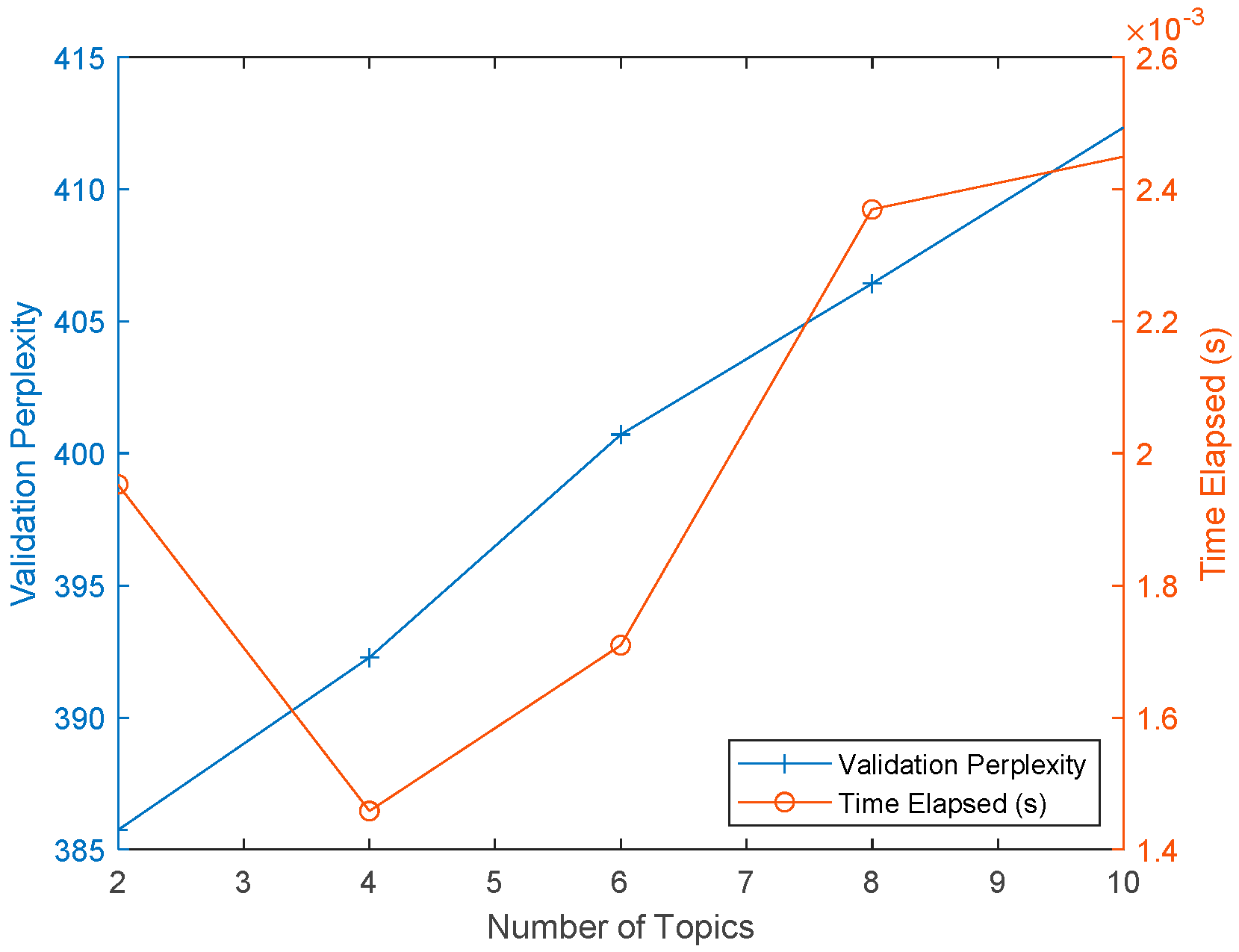
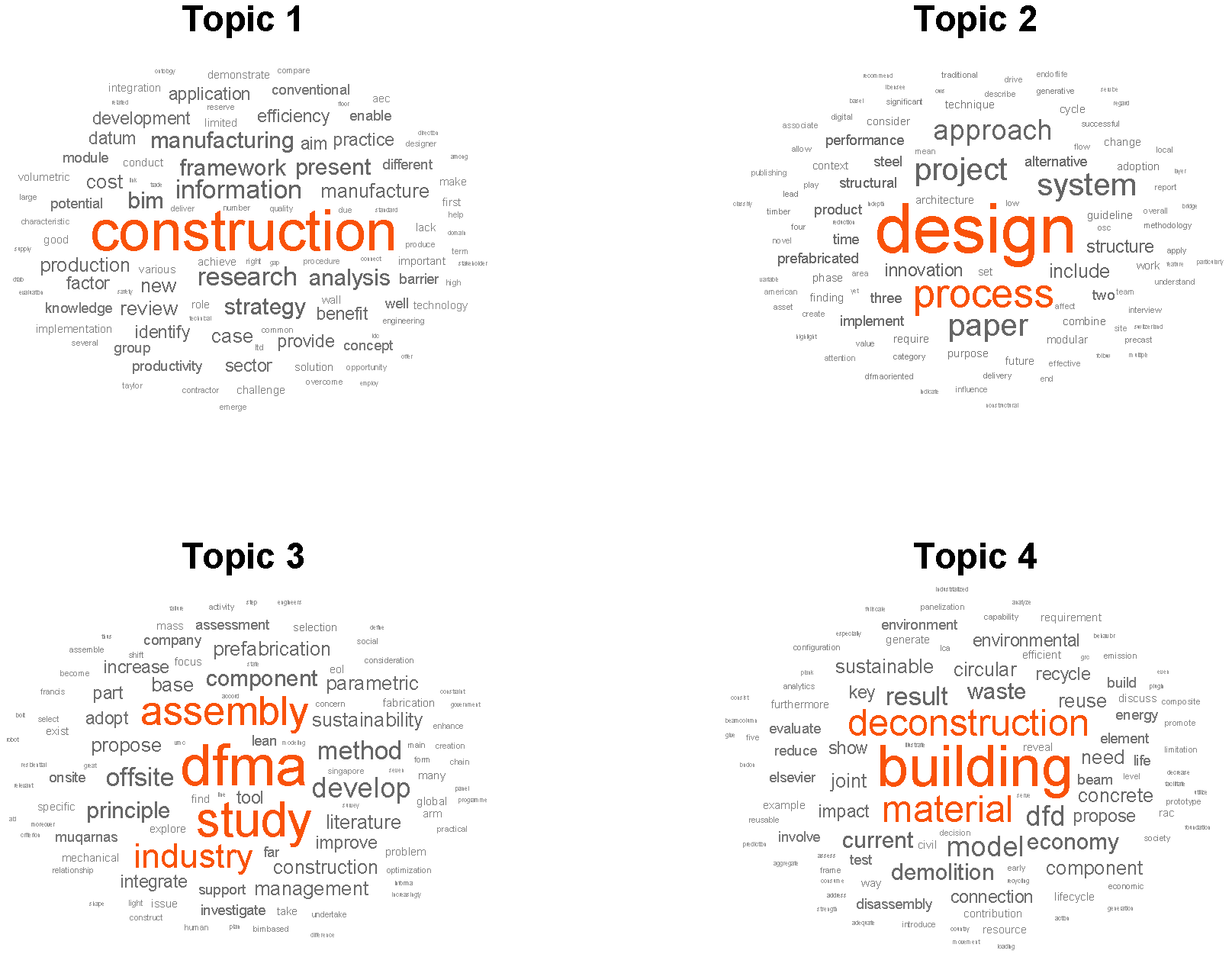
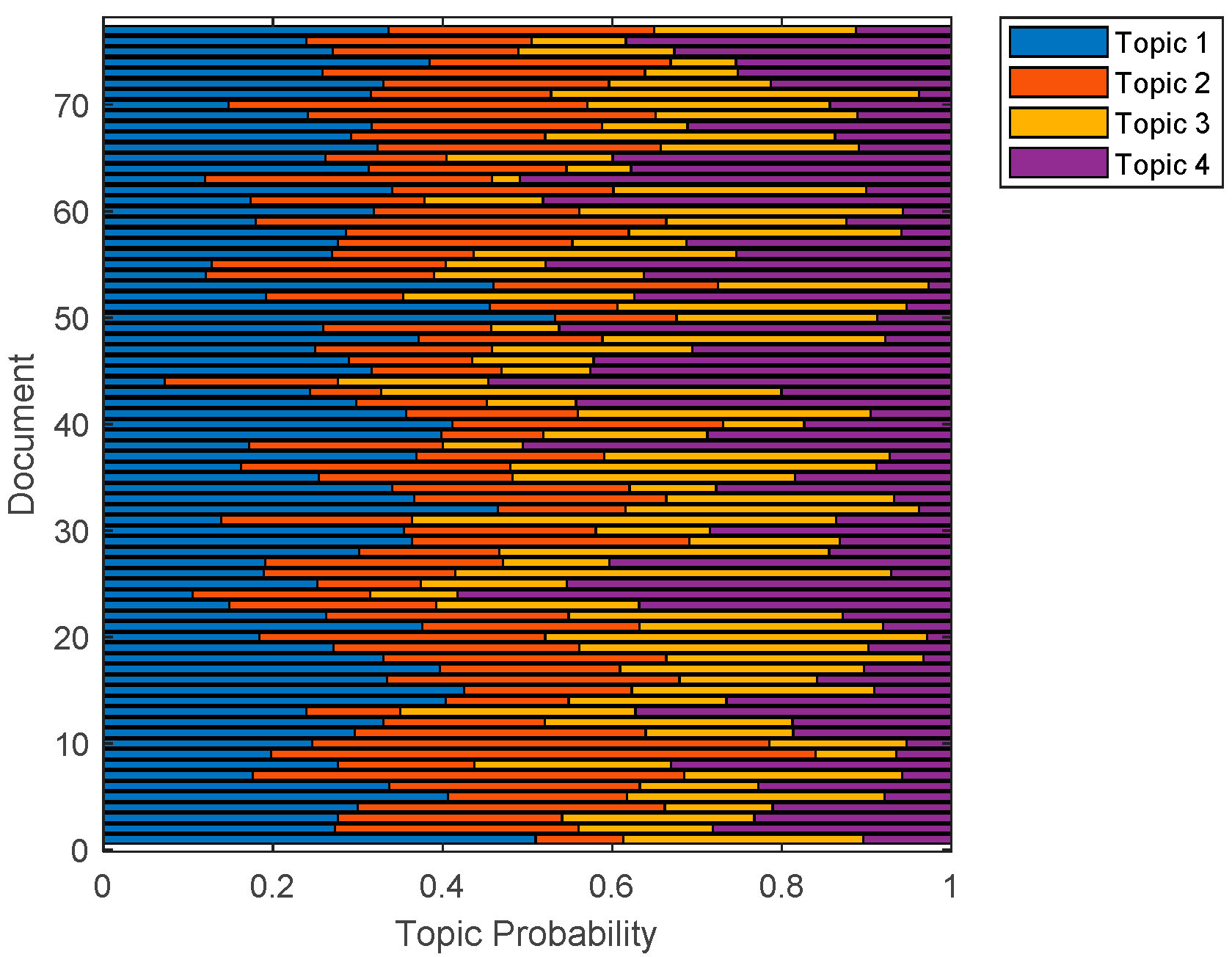
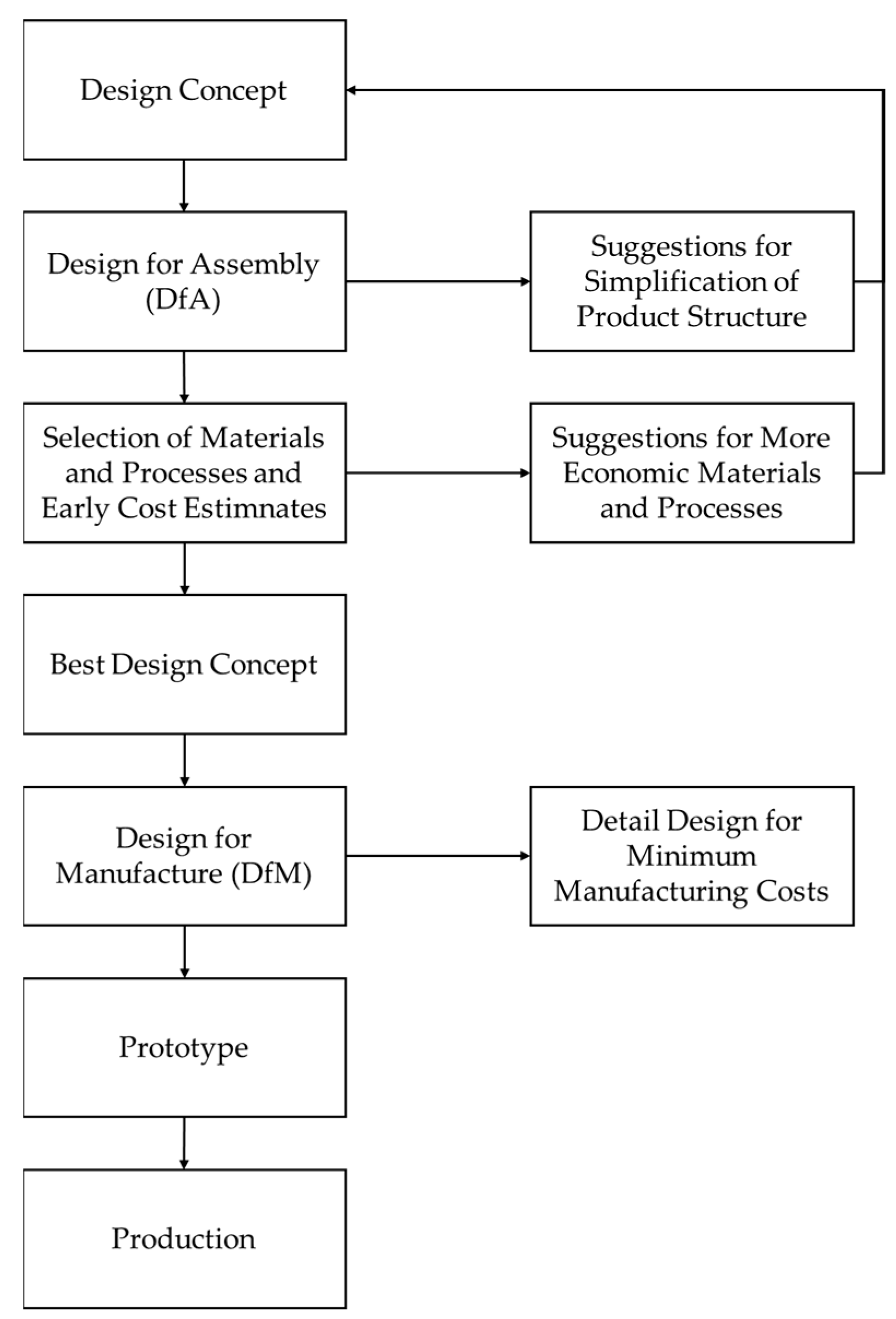
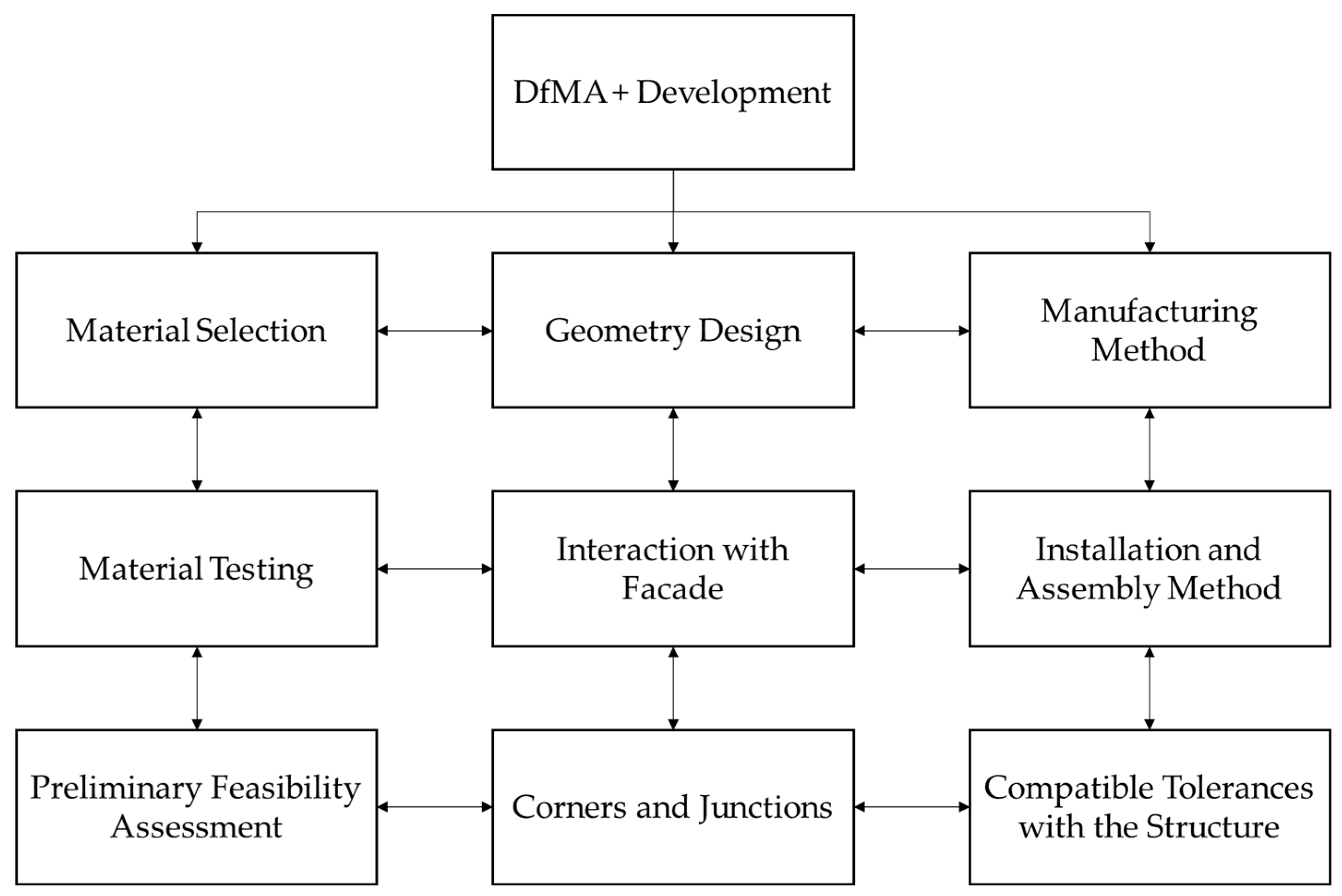
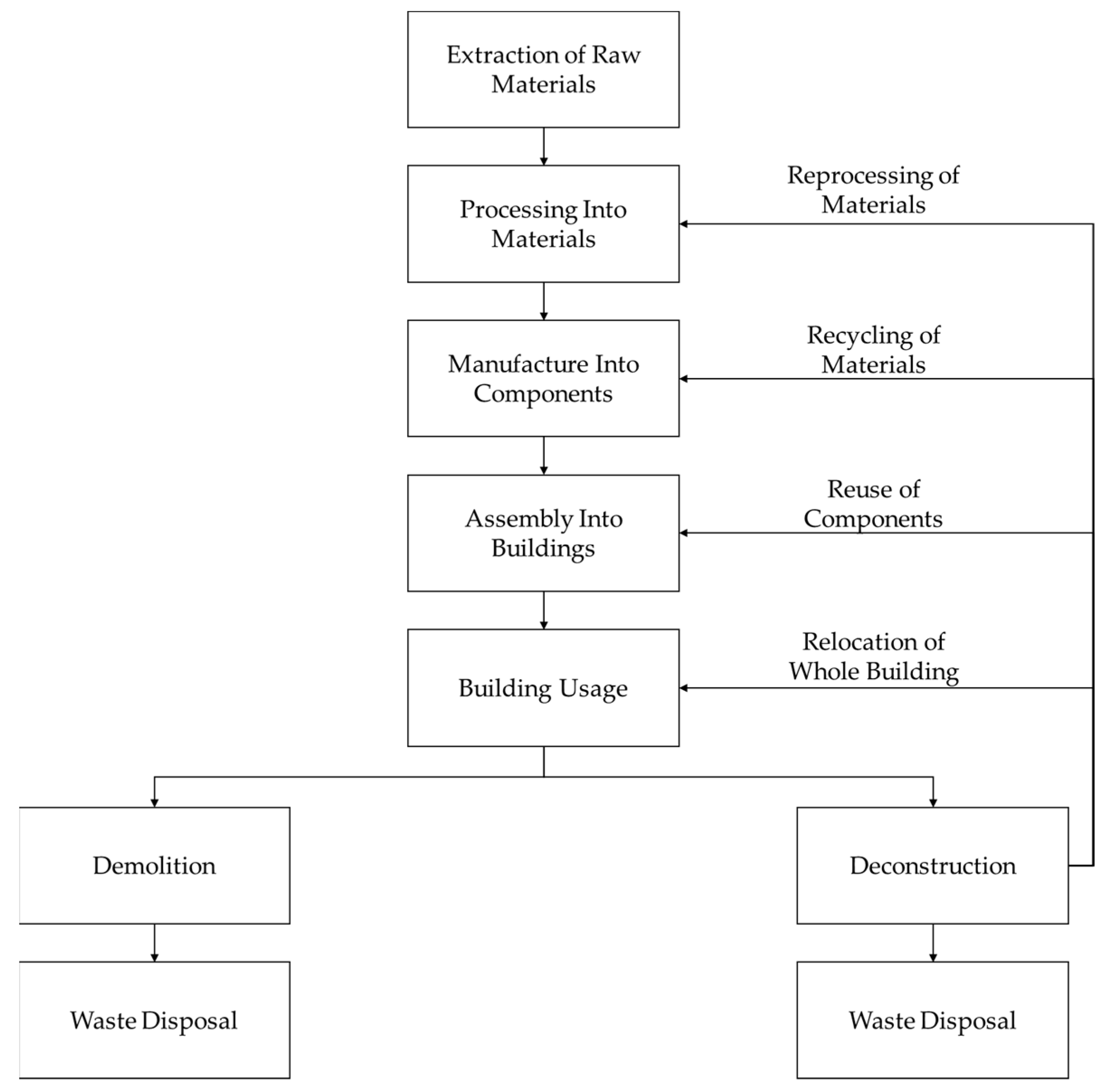
| LDA Topics | Interpretation |
|---|---|
| Design, process | An overview of DfMA and DfD |
| DFMA, study, assembly, industry | DfMA in the construction industry |
| Building, deconstruction, material | DfD in the construction industry |
| Construction | Integration of DfMA and DfD in the construction industry |
| Guidelines | Benefits |
|---|---|
| Reduce the number of components | Enhanced reliability, decrease in expenditures and inventory expenses, ease of installation |
| Use standardized parts | Decrease in expenses, faster material acquisition, enhanced reliability |
| Reduce and standardize fasteners and connections | Decrease in expenses, ease of installation, enhanced reliability, easy maintenance and repair |
| Avoid utilizing dissimilar components | Ease of connections, decrease in fabrication processes |
| Avoid utilizing fragile components | Decrease in unnecessary expenditures resulting from component failure, simplified handling and assembly |
| Avoid over-specifying tolerances or surface finish | Simplified fabrication, decrease in manufacturing expenses |
| Design for easy manufacturing | Decrease in expenses resulting from a simplified design |
| Apply modularization | Decrease in expenses through the simplified installation |
| Eliminate possible errors in the design | Decrease in costs resulting from reduced assembly mistakes |
| Consider ease of handling and orientation | Decrease in expenses because of non-value-added manual effort or dedicated fixturing |
| Incorporate the assembly method in the design | Decrease in expenses due to sufficient assembly knowledge |
| Replace manual methods with automated/robotic assembly | Possible minimization of expenses in comparison to manual techniques |
| Structure/Element | DfMA Guidelines | Benefits of DfMA | References |
|---|---|---|---|
| Bathroom “wet wall” panel | 1. Minimization of parts 2. Optimize design to support easy handling 3. Enhance design to allow simplified insertion 4. Standardization 5. Design using current design methodologies 6. Include margin for alternative design processes | Reductions in time, costs, and waste | [1] |
| Timber frame wall and plumbing drainage system | Boothroyd Dewhurst method [2] 1. Ease of insertion, orientation, and assembly 2. Consideration of symmetry, sizes, and other material properties | DfMA-based construction is three times more efficient than factory-built construction | [3] |
| Curtain wall system | 1. Reduction in the number of components 2. Reduction in the number of unique fasteners for curtain wall assembly on-site 3. Utilization of cost-effective materials 4. Ease of handling in terms of size and weight 5. Reduction in material waste | Reduction in overall expenses and waste and improvement in productivity and quality | [4] |
| Precast bridge components | 1. Simplification of design 2. Minimize the number of components 3. Standardization 4. Simplification of handling, assembly, and orientation of parts | DfMA-based precast components introduce the possibility of bridge design standardization | [5] |
| 40 story mixed-use development | 1. Modularization of structure members, MEP systems, and fit-out 2. Reduction in the number of parts 3. Optimization of various aspects involved in the building’s structural form 4. Ease of connection between precast components | Advantages of DfMA were noted in all aspects, including improved efficiency, reduced expenses and waste by-products, optimized safety and quality, and improved reliability | [6] |
| Themes | Principles | References |
|---|---|---|
| Simplification of building design | Minimize the number of building components and component types | [18,57,88] |
| Modularization | [18,57,88,89] | |
| Standardization | [88,89] | |
| Use of off-site construction and prefabrication | [18,57,88,89] | |
| Use of lightweight components | [18,57,88] | |
| Use of tools and equipment | [89] | |
| Reduction in the number of structural systems | [90] | |
| Utilization of dry construction | [90] | |
| Realization of accessible technical installations | [18] | |
| Utilization of an open building design | [57,88] | |
| Incorporation of a structural grid | [57,88] | |
| Consider the interchangeability of building components | [88] | |
| Materials and connections | Use of reusable materials | [18,57,90] |
| Use of environmentally safe materials | [18,90] | |
| Simplification of the connections | [18,89] | |
| Utilization of mechanical connections | [57,88] | |
| Ease of removal of connections | [89] | |
| Minimize the number of connections and connection types | [57,88,89] | |
| Design materials and connections for longevity and durability | [57,88,89] | |
| Accessibility of components and connections | [89] | |
| Reduce the different types of materials | [18,57] | |
| Use of non-hazardous materials | [18,57,88,90] | |
| Avoid using composite materials | [18,57,88] | |
| Avoid applying secondary finishes | [57,88] | |
| Storage of spare parts for unforeseen minor revisions | [57] | |
| Determine and apply the optimal material size | [57] | |
| Identify the lifespan of each material | [88] | |
| Determine the performance of each material at the building’s end-of-life | [88] | |
| Deconstruction details and information | Documentation of technical plans, drawings, and pictures | [18] |
| Database of materials, components, and building information | [18,57] | |
| Instructions for materials to be reused and recycled | [18,88] | |
| Incorporate the type and method of deconstruction in the design | [89,90] | |
| Viewing a building as a multilayered structure possessing distinct lifespans | [88,90] | |
| Determine the parts of the building system to be deconstructed | [57] | |
| Consideration of parallel disassembly in the design | [57] | |
| Allow easy accessibility to the entire building | [57] | |
| Create a deconstruction and waste management plan | [88] |
| Structure/Element | DfD Approach | Findings | References |
|---|---|---|---|
| Beam-column joint | Development of a novel concrete beam-column joint that can be easily disassembled | 1. Joints exhibited satisfactory seismic performance 2. Acceptable performance of recycled aggregate concrete joints 3. Easy disassembly of joints | [92] |
| Beam-column joint | Development of a novel concrete beam-column joint that can be easily disassembled | 1. Joints demonstrated adequate performance against cyclic loads 2. Reduced carbon footprint throughout the structure’s entire service life | [93] |
| Bolted connection | Development of a demountable steel bolted connection | 1. Rotation and slippage may occur 2. Staggered bolt arrangement provided minimal benefit 3. Put-out and cracking may occur 4. Improvement in connection’s structural performance required | [95] |
| Barn | Application of DfD to construct a barn for housing dairy cows | 1. Structural integrity was retained in the DfD structure | [96] |
Disclaimer/Publisher’s Note: The statements, opinions and data contained in all publications are solely those of the individual author(s) and contributor(s) and not of MDPI and/or the editor(s). MDPI and/or the editor(s) disclaim responsibility for any injury to people or property resulting from any ideas, methods, instructions or products referred to in the content. |
© 2023 by the authors. Licensee MDPI, Basel, Switzerland. This article is an open access article distributed under the terms and conditions of the Creative Commons Attribution (CC BY) license (https://creativecommons.org/licenses/by/4.0/).
Share and Cite
Roxas, C.L.C.; Bautista, C.R.; Dela Cruz, O.G.; Dela Cruz, R.L.C.; De Pedro, J.P.Q.; Dungca, J.R.; Lejano, B.A.; Ongpeng, J.M.C. Design for Manufacturing and Assembly (DfMA) and Design for Deconstruction (DfD) in the Construction Industry: Challenges, Trends and Developments. Buildings 2023, 13, 1164. https://doi.org/10.3390/buildings13051164
Roxas CLC, Bautista CR, Dela Cruz OG, Dela Cruz RLC, De Pedro JPQ, Dungca JR, Lejano BA, Ongpeng JMC. Design for Manufacturing and Assembly (DfMA) and Design for Deconstruction (DfD) in the Construction Industry: Challenges, Trends and Developments. Buildings. 2023; 13(5):1164. https://doi.org/10.3390/buildings13051164
Chicago/Turabian StyleRoxas, Cheryl Lyne C., Carluz R. Bautista, Orlean G. Dela Cruz, Rhem Leoric C. Dela Cruz, John Paul Q. De Pedro, Jonathan R. Dungca, Bernardo A. Lejano, and Jason Maximino C. Ongpeng. 2023. "Design for Manufacturing and Assembly (DfMA) and Design for Deconstruction (DfD) in the Construction Industry: Challenges, Trends and Developments" Buildings 13, no. 5: 1164. https://doi.org/10.3390/buildings13051164
APA StyleRoxas, C. L. C., Bautista, C. R., Dela Cruz, O. G., Dela Cruz, R. L. C., De Pedro, J. P. Q., Dungca, J. R., Lejano, B. A., & Ongpeng, J. M. C. (2023). Design for Manufacturing and Assembly (DfMA) and Design for Deconstruction (DfD) in the Construction Industry: Challenges, Trends and Developments. Buildings, 13(5), 1164. https://doi.org/10.3390/buildings13051164








